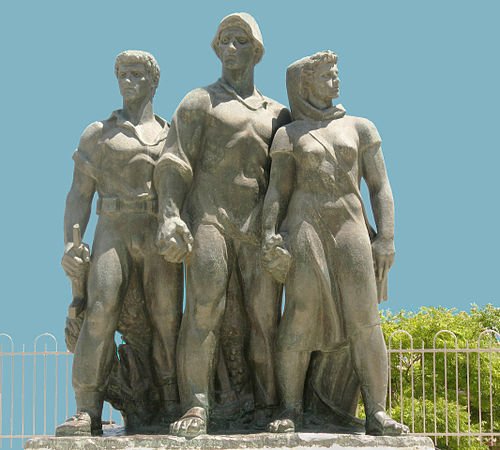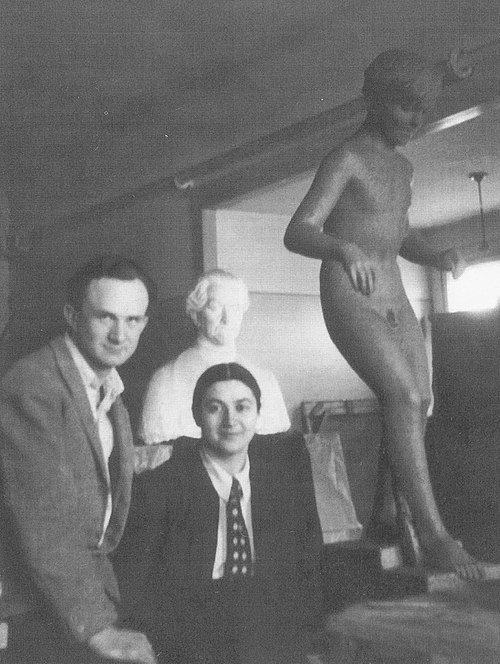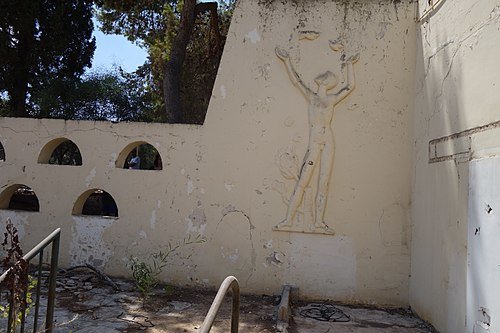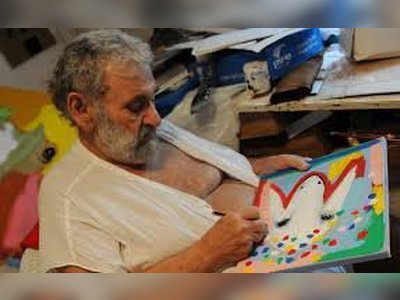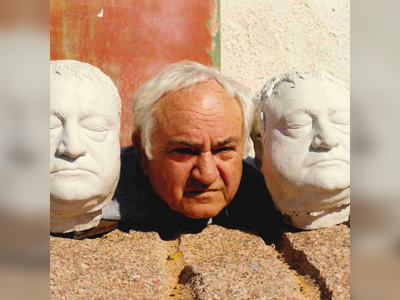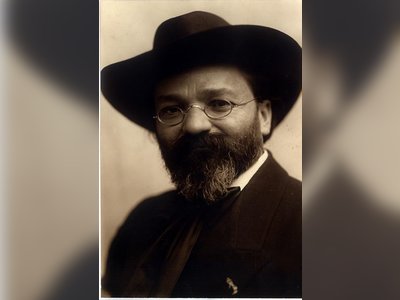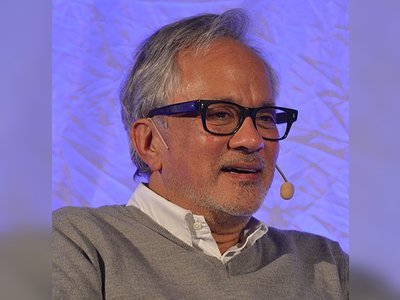מורשת גדולי האומה
בזכותם קיים
beta
Nathan Jacob Rapoport
Was a Jewish sculptor, painter, and photographer born in Warsaw, Poland. His most significant and renowned works are dedicated to commemorating the Holocaust victims and resistance fighters.
Nathan Rapoport was born in 1911 in Warsaw, then part of the Russian Empire (later the capital of the Republic of Poland). He was born into a religious Jewish family, the son of Chaya Kupelwicz and Yaakov Ben Shlomo Zalman, from the Kohanim family lineage. He attended religious studies at "Talmud Torah" and the Jewish high school for boys, "Lior," located on Nalewki Street, which was the center of Jewish life in the city. Due to his father's illness, he had to leave school prematurely and began working to support his family. In 1927, Rapoport registered for sculpture studies at the Municipal School of Arts in Warsaw.
In 1928, he joined the Hashomer Hatzair youth movement in Warsaw and remained a member of the movement's Ken (local group) until 1933. After about three years, Rapoport continued his studies at the Academy of Fine Arts (ANSA), where he received a scholarship that allowed him to visit museums in Italy and France. Although his sculpture titled "The Tennis Player" won first place in a competition in 1936, Rapoport was disqualified from the prize because he refused to send his work to be displayed in Nazi Germany.
In 1938, Rapoport received another scholarship, which enabled him to study at the École des Beaux-Arts in Paris. With the outbreak of World War II in 1939, Rapoport fled from Poland to Bialystok, which had been occupied by the Soviet Union. During his time in the Soviet Union, he created sculptures and portraits of Soviet officials. While witnessing the events of the war, Rapoport began documenting his memories, particularly the destruction of the Warsaw Ghetto in late 1942.
In 1946, Rapoport arrived in Warsaw from Moscow and presented his plaster model. In 1947, he completed the final design in Paris to cast it in bronze. On April 19, 1948, marking the fifth anniversary of the Warsaw Ghetto Uprising, the Ghetto Uprising Monument, created by Rapoport, was unveiled at the site of the former ghetto, now a memorial.
In early 1949, Rapoport immigrated to Israel, beginning a unique artistic journey in the country. He started his work as a democratic artist, creating two different models of a sculpture representing Mordechai Anielewicz, the leader of the Warsaw Ghetto Uprising, each measuring about 90 cm in height. He allowed the members of Kibbutz Yad Mordechai to choose the sculpture they preferred through a democratic process. The sculpture that was not chosen is still on display at the "Masuah – A Living Museum of the Holocaust" in Kibbutz Yad Mordechai.
Two years later, he worked on the "Defenders" sculpture for Kibbutz Negba, once again involving the kibbutz members in the selection process. In 1959, he immigrated to the United States and became a naturalized citizen in 1965. He resided in Searingtown, New York, and Manhattan.
In 1985, the "Liberation" monument, created by Rapoport, was unveiled at Liberty State Park in New Jersey. The monument depicts an American soldier carrying a liberated survivor from a Nazi concentration camp in his arms, symbolizing the role of the United States in liberating the Nazi concentration camps.
Nathan Rapoport was awarded the Herbert Adams Memorial Medal by the National Sculpture Society in recognition of his contribution to American sculpture.
He passed away in New York in the summer of 1987 at the age of 75 and was buried in Petah Tikva, Israel. He left behind a daughter, Nina Wolmark, who resides in Paris, as well as grandchildren and great-grandchildren.
Rapoport's extensive archive, including hundreds of illustrated letters, drawings of sculptures, prints, and photographs taken by the artist of his own works, is preserved in the archives of Hashomer Hatzair Youth Movement at Yad Yaari, Israel.
Rapoport's studio on Rokach Street in Ramat Gan, known as the "Nathan Rapoport House," currently serves as an art center and houses several small sculptures by the artist, along with some of his tools and work equipment.
Nathan Rapoport's biography reflects the life and artistic journey of a sculptor deeply impacted by the Holocaust, who dedicated his art to preserving the memory of those who suffered and resisted during this dark period in history. His sculptures continue to serve as powerful reminders of the atrocities of the Holocaust and the resilience of the human spirit.
In 1928, he joined the Hashomer Hatzair youth movement in Warsaw and remained a member of the movement's Ken (local group) until 1933. After about three years, Rapoport continued his studies at the Academy of Fine Arts (ANSA), where he received a scholarship that allowed him to visit museums in Italy and France. Although his sculpture titled "The Tennis Player" won first place in a competition in 1936, Rapoport was disqualified from the prize because he refused to send his work to be displayed in Nazi Germany.
In 1938, Rapoport received another scholarship, which enabled him to study at the École des Beaux-Arts in Paris. With the outbreak of World War II in 1939, Rapoport fled from Poland to Bialystok, which had been occupied by the Soviet Union. During his time in the Soviet Union, he created sculptures and portraits of Soviet officials. While witnessing the events of the war, Rapoport began documenting his memories, particularly the destruction of the Warsaw Ghetto in late 1942.
In 1946, Rapoport arrived in Warsaw from Moscow and presented his plaster model. In 1947, he completed the final design in Paris to cast it in bronze. On April 19, 1948, marking the fifth anniversary of the Warsaw Ghetto Uprising, the Ghetto Uprising Monument, created by Rapoport, was unveiled at the site of the former ghetto, now a memorial.
In early 1949, Rapoport immigrated to Israel, beginning a unique artistic journey in the country. He started his work as a democratic artist, creating two different models of a sculpture representing Mordechai Anielewicz, the leader of the Warsaw Ghetto Uprising, each measuring about 90 cm in height. He allowed the members of Kibbutz Yad Mordechai to choose the sculpture they preferred through a democratic process. The sculpture that was not chosen is still on display at the "Masuah – A Living Museum of the Holocaust" in Kibbutz Yad Mordechai.
Two years later, he worked on the "Defenders" sculpture for Kibbutz Negba, once again involving the kibbutz members in the selection process. In 1959, he immigrated to the United States and became a naturalized citizen in 1965. He resided in Searingtown, New York, and Manhattan.
In 1985, the "Liberation" monument, created by Rapoport, was unveiled at Liberty State Park in New Jersey. The monument depicts an American soldier carrying a liberated survivor from a Nazi concentration camp in his arms, symbolizing the role of the United States in liberating the Nazi concentration camps.
Nathan Rapoport was awarded the Herbert Adams Memorial Medal by the National Sculpture Society in recognition of his contribution to American sculpture.
He passed away in New York in the summer of 1987 at the age of 75 and was buried in Petah Tikva, Israel. He left behind a daughter, Nina Wolmark, who resides in Paris, as well as grandchildren and great-grandchildren.
Rapoport's extensive archive, including hundreds of illustrated letters, drawings of sculptures, prints, and photographs taken by the artist of his own works, is preserved in the archives of Hashomer Hatzair Youth Movement at Yad Yaari, Israel.
Rapoport's studio on Rokach Street in Ramat Gan, known as the "Nathan Rapoport House," currently serves as an art center and houses several small sculptures by the artist, along with some of his tools and work equipment.
Nathan Rapoport's biography reflects the life and artistic journey of a sculptor deeply impacted by the Holocaust, who dedicated his art to preserving the memory of those who suffered and resisted during this dark period in history. His sculptures continue to serve as powerful reminders of the atrocities of the Holocaust and the resilience of the human spirit.
- נתן רפפורטhe.wikipedia.org
